Our survey says….

Surveys. I’ve touched on the usual suspects upholding their own data as though it was the Holy Grail before. ASH is utterly remorseless when it comes to trumpeting their own data, usually for their own means, and they also heap scorn on data that contradicts their sacrosanct view of the populace. Typically, in the UK we have two primary sets of survey data on smoking - the ASH survey (hosted by YouGov) and of course the Smoking Toolkit Study.
Both of these, along with many others run by Cancer Research UK, consistently show that never-smoking-teens rarely pick up e-cigs. They also consistently show little or no progression from e-cigs to combustible tobacco. They also consistently show a decrease in smoking prevalence at the same time there’s an increase in e-cig prevalence. It’s hardly the silver bullet to prove (or disprove) “gateway” theories correct or otherwise; after all it is still perfectly feasible that some insanely curious folks will experiment with both. It’ll happen.
Our friends in the US also have their surveys. Two have recently had their data updated with this years data. The National Youth Tobacco Survey (NYTS) and the Monitoring The Future survey. One looks at 8-10th graders, while the other is more population level. Both surveys contain very useful raw data - the vast majority of which will be lost among the media headlines (natch), especially since the media (mostly) refer to e-cigs as “tobacco products”. We know that in the US, thanks to a legal definition, nicotine “derived from tobacco” is a tobacco product, and thus anything that contains nicotine is classified as a tobacco product. Of course, the FDA in its “wisdom” have unilaterally extended that definition (more like stretched it to fit) to encompass non-nicotine containing e-liquid, mods, tanks and most accessories (except lanyards) for e-cigs as tobacco products.
This of course has resulted in many tongue in cheek comments that anything containing nicotine - such as the humble aubergine - must also be a tobacco product. Rightly or wrongly the definition extension - based solely on a legal interpretation - to include e-cigs, non-nicotine liquid and the various consumables is here to stay.
https://twitter.com/cjsnowdon/status/808405099525586944
Y’see, when it comes to representing the data folk see a large bar, or a steeply inclining line and think “shock, horror” - especially, as is the case here, vital context is missing. Well let’s put back some of that context shall we?
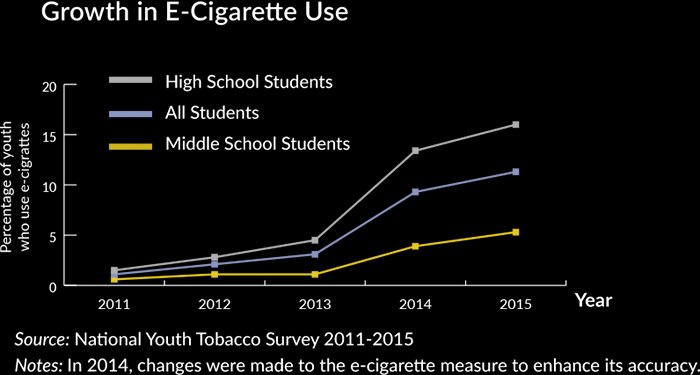
See, the first thing I noticed was the note.
In 2014, changes were made to the e-cigarette measure to enhance its accuracy.
Aside from nearly splitting my sides with laughter, I was curious as to what the change was to make this survey “more accurate”. So I went off and downloaded their data. It’s freely available in Microsoft Access format, complete with codebook (which also contains the raw results). They also have digital copies of their actual questions. I say digital copies as their completion directions are:
- Use a #2 pencil only
- Make dark marks
- Fill in responses like this
- If you change your answer, erase your old answer completely
So pencil and paper questions. Come on folks, get with the digital age!
The questionnaire is broken into various sections, but the one I’m specifically looking at is the one entitled:
The next three questions are about other forms of tobacco
Think you can guess what comes under this section can’t you? There’s only three questions in the 2013 version of this questionnaire:
- Which of the following tobacco products have you ever heard of? 1. Roll-your-own cigarettes 2. Flavoured cigarettes, such as Camel Crush 3. Bidis 4. Clove cigars 5. Flavoured little cigars 6. Smoking tobacco from a hookah or a waterpipe 7. Snus, such as Camel or Marlboro Snus 8. Dissolvable tobacco products 9. E-Cigarettes 10. Some other new tobacco products not listed here 11. I have never heard of any of the products listed above or any new tobacco product
Well if the kiddies didn’t know about these products before, they sure do now. To follow up on this question, they then ask which of the following tobacco products have you ever tried, even just one time. At a guess, this question is aimed at trying to identify anyone who experiments with “tobacco” of any kind. Which you can probably guess is a very good thing for them, ‘cos tax and revenue streams.
Finally, we come to the “use” question. Which, in 2013 is pretty dire.
- In the past 30 days, which of the following products have you used on at least one day? 1. Roll-your-own cigarettes 2. Flavoured cigarettes, such as Camel Crush 3. Bidis 4. Clove cigars 5. Flavoured little cigars 6. Smoking tobacco from a hookah or a waterpipe 7. Snus, such as Camel or Marlboro Snus 8. Dissolvable tobacco products 9. E-Cigarettes 10. Some other new tobacco products not listed here 11. I have not used any of the products listed above or any new tobacco product in the past 30 days
Now of course, the “use on at least one day” in the past month, by any sensible reckoning, doesn’t equate current use, but that’s exactly what the US define it as. In 2013, 526 out of 18,406 were classified as “current users” of e-cigarettes. That is a whopping…er… 2.9%. This is how the “use” looks, per grade in 2013:
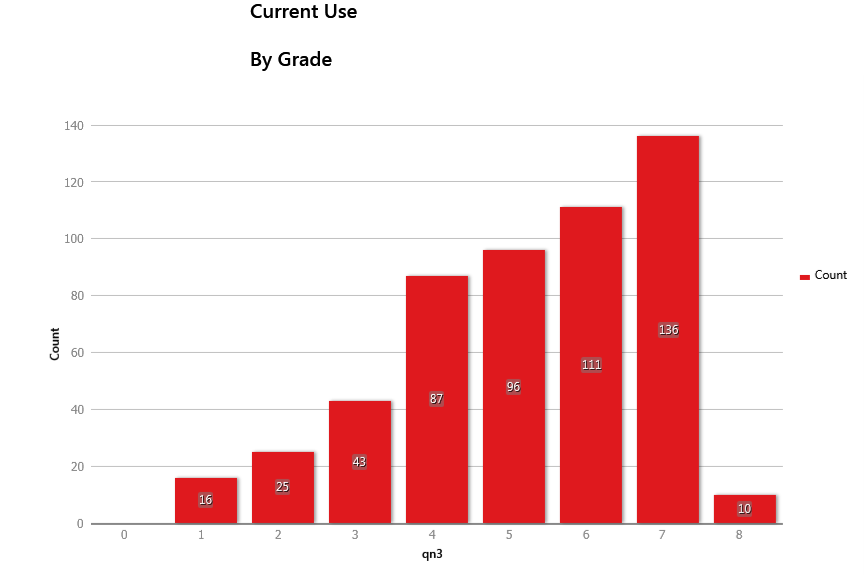
Now let’s have a look at the “use” of combustible tobacco - specifically cigarettes:
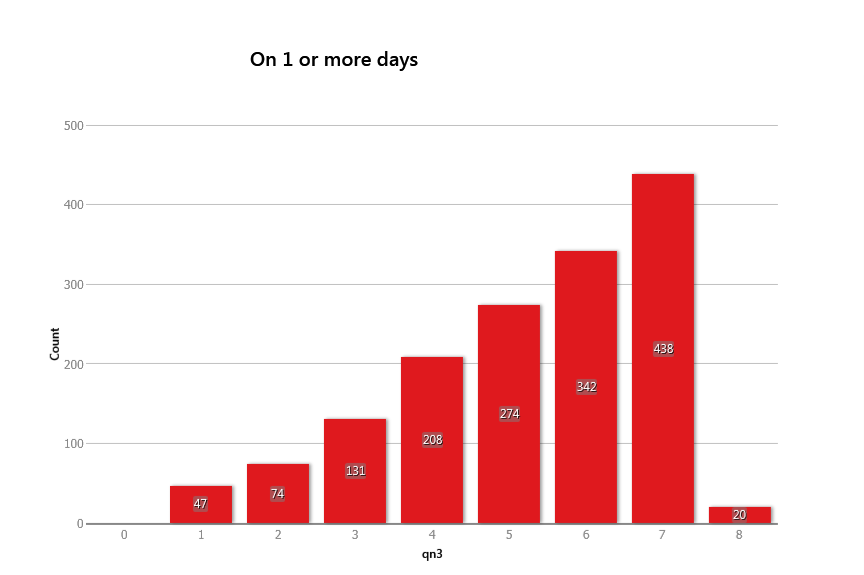
In the “highest risk” group - the lower grades 7, 8 & 9 - e-cig “use” equaled 84. In comparison, “current use” of cigarettes in the same age bracket was 252. Out of 18,406. In both charts, the numbers rise as the student gets older - well it would, it’s called growing up and being curious. But hang on a minute, which set of figures are they using for “use” in the media do you think? Is it likely to be the “current use” as shown above, or this one:
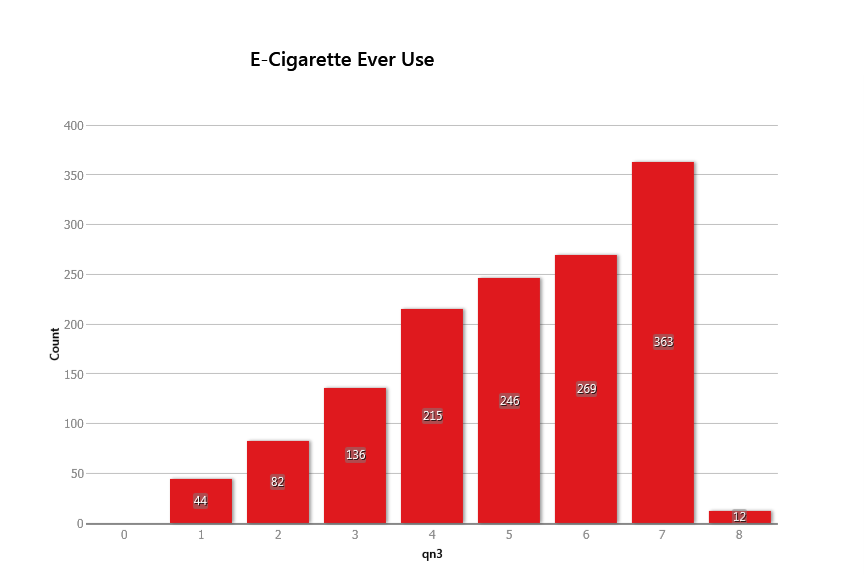
Which shows “ever use”. Notice how the two give completely different results? For middle school the total is 262, while high schoolers - those rascals - totaled 1105 as opposed to 440.
Fast forward twelve months to the “more accurate” survey in 2014.
So what are they asking now?
- Have you ever been curious about using an electronic cigarette?
Wait, curious? What on earth? No doubt trying to gauge the “appeal” of the supposed “kiddie-centric” marketing tactics of those evil, nasty vape shops. Yet, they clearly state “such as Blu, 21st Century Smoke or NJOY”. Blu is owned by a tobacco company, while 21st Century and NJOY are independents. There’s four possible answers to this - definitely yes, probably yes, probably not, definitely not. Well that’s definitive isn’t it? By the way, over 70% answered “probably not” and “definitely not” with only 13.2% saying “definitely yes” and 14.4% saying “probably yes”. Hardly a real cause for major concern is it?
- Have you ever tried an electronic cigarette?
Ah, the old “experimentation” question, to which a massive 78.5% said NO with 19.1% saying yes. That’s out of 22,007 by the way.
- Do you think you will try an electronic cigarette soon?
Trying to gauge intentions here no doubt. Looking for that “gateway” theory.
- Definitely yes 6.2%
- Probably yes 9.2%
- Probably not 19%
- Definitely not 64.3%
Not exactly compelling is it? The raw figures taken from these 22,007 little oiks are so far contradicting what US Tobacco Control and Public Health are telling everyone. These e-cigarette manufacturers are targeting our kids - really? When a significant proportion are saying that they won’t be trying one?
- If one of your best friends were to offer you an electronic cigarette, would you use it?
Ah peer pressure. A well documented, though often misunderstood phenomenon. Most kids these days are of the mind - especially at school - that if they don’t want to try something, even if their “bestie” offers it, they aren’t going to try it - and in some cases, that individual will seek a new best friend.
- Definitely yes 8.1%
- Probably yes 12.6%
- Probably not 16.1%
- Definitely not 62%
I’d wager those in the 62% will be seeking a new bestie.
- How old were you when you first tried an e-cigarette
A curious one this, and one worth showing in a chart:
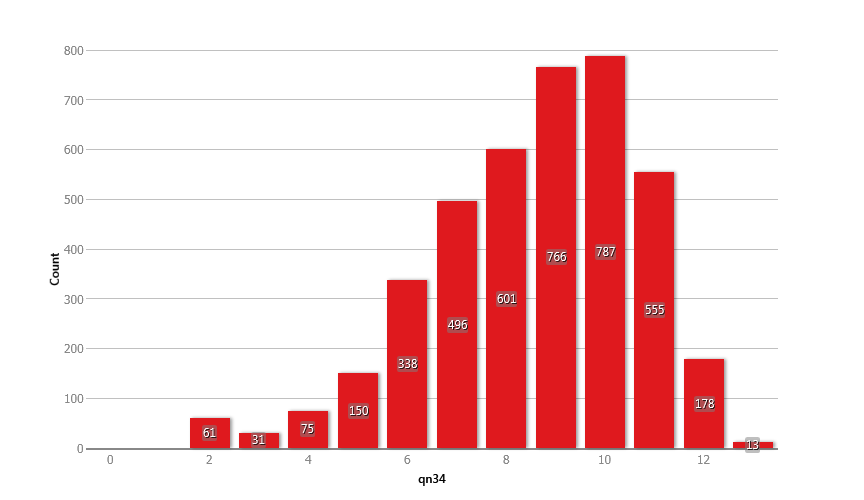
Note: I’ve excluded the result of “I have never used an e-cigarette” which totaled 79.5% (17,505)
So kids start trying things at a young age. Who knew?
For the final question - specifically related to e-cigarettes that is, they have made an effort to be more granular in the data collection, but not in the presentation (natch).
- During the past 30 days, on how many days did you use an e-cigarette?
It’s worth listing the possible answers this time:
- 0 days (as in never
- 1 or 2 days (as in very occasional use)
- 3 to 5 days (nope, still occasional use)
- 6 to 9 days
- 10-19 days
- 20-29 days
- All 30 days (otherwise known as a regular user)
I’d tentatively suggest that anything under 20 days could be classified as “occasional use” and “1 or 2 days” could be viewed as a level of experimentation.
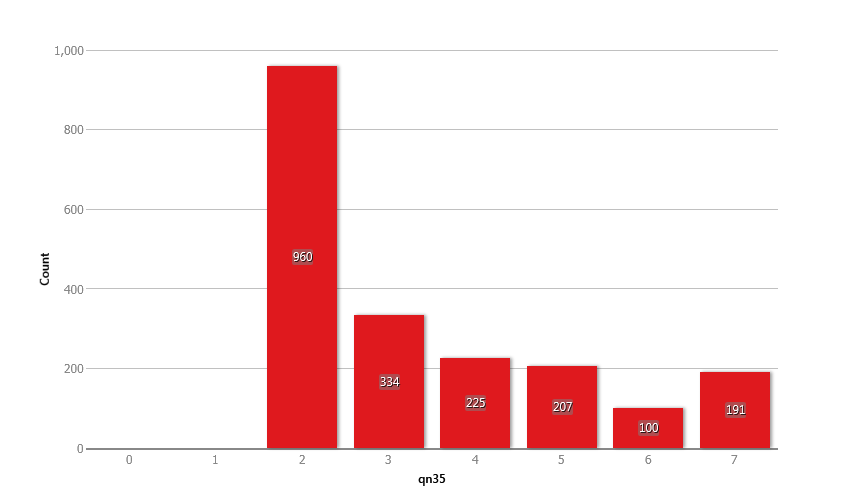
Again, I’ve excluded the result of “0 days” which totaled 19,587 or 89%
So let’s have a little bit of perspective shall we?
Of course, there are many factors to consider when comparing e-cig use against the smoking prevalence rate, but let’s face it - the UK has seen a similar sharp drop in smoking prevalence:
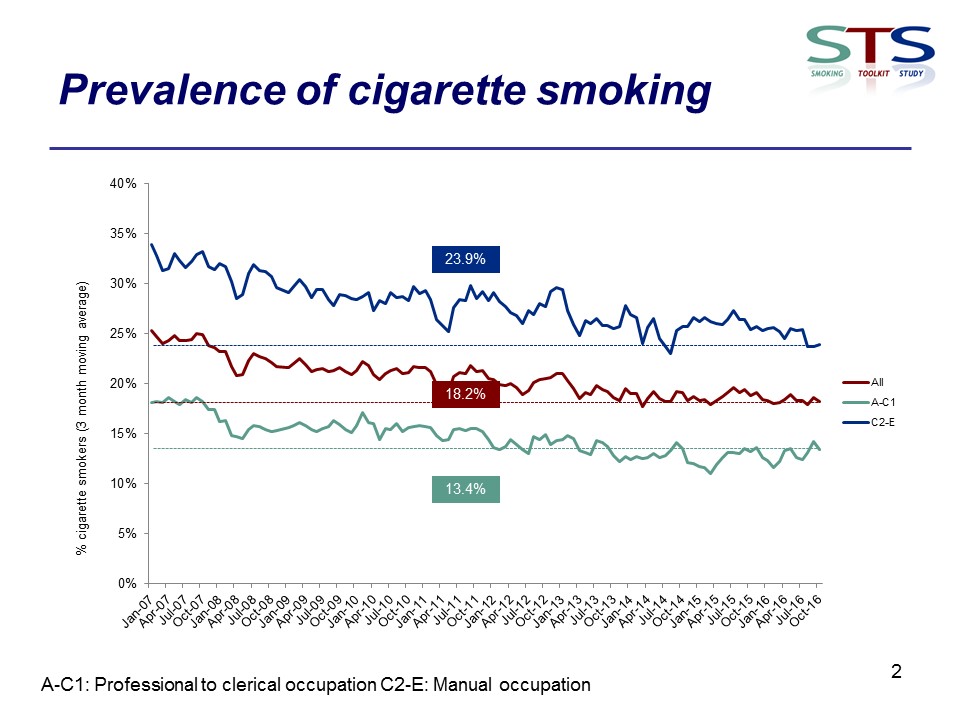
An important point to make here, the STS is relevant specifically for cessation methods and attempts - the fact that it tracks the smoking prevalence is a bonus, but then that is the intention of the survey - to track smoking cessation, and not to track use of e-cigarettes. It just so happens that e-cigarette use is the most common method for “cessation”. Frequency of use isn’t tracked by the STS or ONS, it’s tracked by the smaller surveys, such as ASH’s YouGov (shown below) or Cancer Research UK.
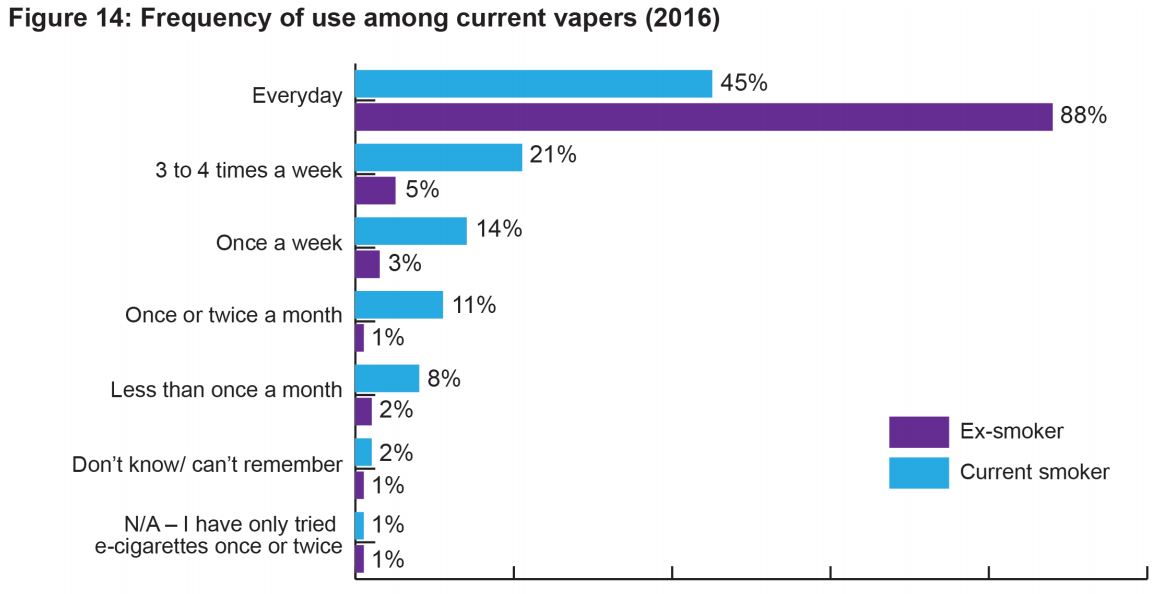
It does highlight a completely different approach to gathering the data - the US are insistent on tracking frequency of e-cigarette use as though it is a bad thing, while the UK tracks it as a “nice to know” piece of data. The focus of both sides is more or less the same, getting its populace smoke-free, or in the case of the US - getting the populace nicotine free. Specifically recreational nicotine free.
Both sides use the data to further policy agendas, usually aimed at making smokers lives more miserable, but only the US (in this particular head-to-head) is using the data to make both smokers & vapers lives miserable.
Tell me, is that really about health?
(image credit zimmytws/shutterstock.com)